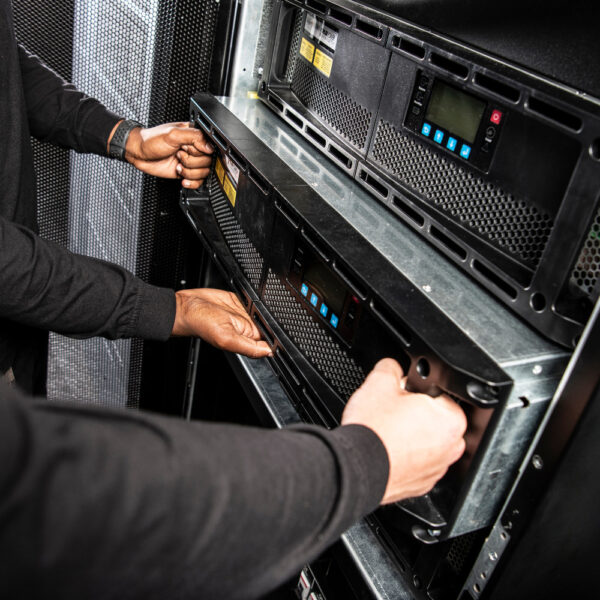In the realm of life safety systems, emergency lighting is not just a legal requirement—it’s a critical component of protecting human life during power outages and emergency situations. Whether in commercial buildings, hospitals, industrial facilities, or public infrastructure, the ability to provide reliable illumination during a power failure can mean the difference between safe evacuation and chaos. One question that we often get asked is whether to use an uninterruptible power supply (UPS) or a static inverter for emergency lighting systems. At first glance, these two technologies might seem interchangeable. However, after delving into the technical details, operational implications, and regulatory context, the distinctions between them are significant—and understanding those differences is essential for making informed decisions.
The choice between a UPS and a static inverter directly affects system design, reliability, compliance, and overall cost. With increasing emphasis on building safety standards and sustainability, facility managers, electrical engineers, and decision-makers can’t afford to take a one-size-fits-all approach. Emergency lighting systems must be tailored not just for functionality, but for compliance and long-term resilience.
What is Central Battery for Emergency Lighting?
Central battery for emergency lighting refers to a system where a single, centralised power source—typically a battery bank with a static inverter —supplies emergency power to all emergency luminaires throughout a building. This contrasts with self-contained (or “standalone”) emergency lights, which each have their own internal battery. Central battery systems offer several advantages: easier maintenance, longer battery lifespan and simplified testing and monitoring through a centralised control.
The core component of a central battery system is how it converts and delivers power during an outage. This is where the distinction between a UPS and a static inverter becomes crucial. Understanding the role these devices play is the first step in evaluating which solution best fits a given application.
UPS vs Static Inverter: What’s the core difference?
In simplistic terms, a UPS and a static inverter differ due to their design purpose. A UPS is primarily built to provide instantaneous backup power to critical electronic equipment—like servers and IT infrastructure—without any interruption. It achieves this by using an online double-conversion process: AC power is first converted to DC to charge the batteries, then reconverted back to AC to supply the load, ensuring a seamless, continuous power output even during a switchover.
A static inverter, by contrast, is designed specifically for emergency lighting applications. While it also provides AC output during a power failure, it often operates in standby mode (off-line) during normal conditions, only activating the inverter when the mains power fails. Static inverters are designed to comply with emergency lighting standards such as BS EN 50171 (Central Power Supply Systems), which sets requirements for autonomy duration, battery discharge characteristics, MCB sizes and operational reliability in life safety applications.
This distinction is critical because using a UPS instead of a static inverter in emergency lighting applications may result in non-compliance with safety codes—and potentially compromise the system’s reliability in a real-world emergency.
Regulatory Compliance and Standards
Emergency Lighting systems are heavily regulated and these regulations dictate the suitability of power backup solutions. Standards like BS EN 1838 (Lighting Applications – Emergency Lighting), BS 5266 (Emergency Lighting Code of Practice), and BS EN 50171 cover everything from performance requirements to installation protocols.
Static inverters are purpose-built to meet these requirements, including stipulated battery discharge times (typically 1 or 3 hours), automatic testing features, and compatibility with specific emergency luminaires. UPS systems, unless explicitly designed and certified for life safety applications, may not meet these criteria.
This is important for readers who are specifying systems or involved in compliance audits. Choosing a power supply that fails to meet emergency lighting regulations can result in legal liability, insurance complications, and—most importantly—put lives at risk during an emergency.
System Design and Operational Impact
Another critical consideration involves how each system integrates with building infrastructure. Because UPS systems may lack dedicated outputs for different lighting modes or fail-safe designs needed for fire safety scenarios.
Static inverters, on the other hand, are designed with features like maintained/non-maintained lighting output, fail-safe relay contacts, and compatibility with central test and monitoring systems. They also allow for selective circuit monitoring and easier integration with fire alarm systems, providing a more holistic and resilient emergency lighting solution.
Understanding this matters because the operational characteristics of these systems will directly influence how quickly and safely occupants can evacuate a building under duress. It also impacts the complexity and cost of ongoing system.
To find out more about how we can help with your Emergency Lighting requirements, please get in touch – [email protected]
Why not take a read of our free guide to Emergency Lighting – Switch On: Specifing and maintaining emergency lighting systems for life safety.






